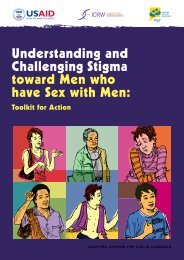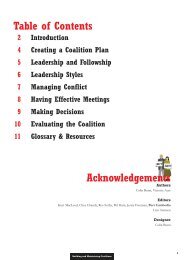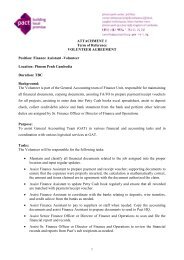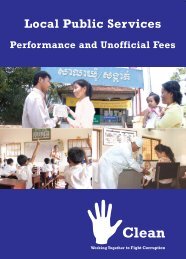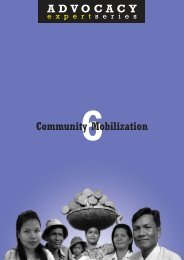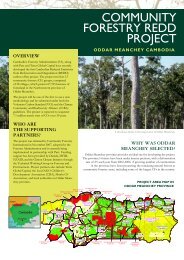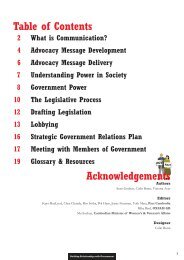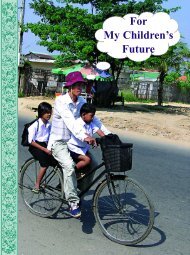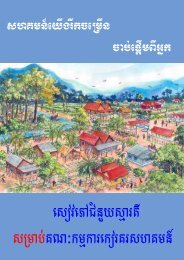Advocacy in Cambodia: Increasing Democratic ... - Pact Cambodia
Advocacy in Cambodia: Increasing Democratic ... - Pact Cambodia
Advocacy in Cambodia: Increasing Democratic ... - Pact Cambodia
Create successful ePaper yourself
Turn your PDF publications into a flip-book with our unique Google optimized e-Paper software.
Case Studies<br />
number of challenges and 158 workers were<br />
dismissed. The company attempted to raise fear<br />
among the public that union-led unrest would<br />
threaten current and future <strong>in</strong>vestment <strong>in</strong><br />
<strong>Cambodia</strong>. Even so, strikers did ga<strong>in</strong> concessions<br />
<strong>in</strong>clud<strong>in</strong>g health benefits, a reduced workweek,<br />
and an <strong>in</strong>crease <strong>in</strong> the base wage from $15 to $27<br />
per month.<br />
FTUWKC’s success motivated workers <strong>in</strong><br />
other factories to protest their work<strong>in</strong>g conditions.<br />
Labor unrest <strong>in</strong>creased throughout the year and<br />
1997 saw numerous demonstrations and the first<br />
labor arbitration by the M<strong>in</strong>istry of Labor. Dur<strong>in</strong>g<br />
this period factories were unwill<strong>in</strong>g to barga<strong>in</strong> and<br />
tension between management and workers was<br />
high. The situation deteriorated after events <strong>in</strong><br />
July 1997, as workers accused companies of<br />
reduc<strong>in</strong>g wages and <strong>in</strong>creas<strong>in</strong>g overtime.<br />
Organized labor grew quickly thereafter and<br />
by early 1999, 59 professional organizations had<br />
registered with the M<strong>in</strong>istry of Labor, <strong>in</strong>clud<strong>in</strong>g<br />
56 trade unions, 2 employer associations, and a<br />
workers federation. Today <strong>Cambodia</strong> has<br />
approximately 200 factory-level unions, grouped<br />
<strong>in</strong>to eight to n<strong>in</strong>e federations. Membership<br />
<strong>in</strong>formation provided by the federations <strong>in</strong>dicates<br />
that approximately 200,000 garment workers are<br />
union members. Experts <strong>in</strong> the field, however,<br />
consider the actual figure to be closer to 100,000,<br />
the vast majority of whom do not pay dues and/<br />
or not aware of their membership.<br />
Factory unions generally focus on improv<strong>in</strong>g<br />
work<strong>in</strong>g and liv<strong>in</strong>g conditions of members by<br />
establish<strong>in</strong>g collective barga<strong>in</strong><strong>in</strong>g with employers,<br />
<strong>in</strong>fluenc<strong>in</strong>g relevant government policies, and<br />
provid<strong>in</strong>g direct services (legal, social, etc.) to<br />
members. Activities undertaken by federations<br />
and unions <strong>in</strong>clude:<br />
• tra<strong>in</strong><strong>in</strong>g union leaders;<br />
• orient<strong>in</strong>g union leaders and workers on the<br />
labor code;<br />
• mediat<strong>in</strong>g collective and <strong>in</strong>dividual<br />
disputes;<br />
• organiz<strong>in</strong>g collective action when disputes<br />
are not resolved;<br />
• represent<strong>in</strong>g unions at the policy level; and<br />
• occasionally provid<strong>in</strong>g support or services<br />
to members (such as health benefits).<br />
In exchange for these services, unions charge<br />
members monthly dues of Riel 1,000 (U.S.$0.25).<br />
This amount is standard for most unions, though<br />
unions have great difficulty collect<strong>in</strong>g dues. The<br />
M<strong>in</strong>istry of Labor recently approved direct payroll<br />
deduction, but this has yet to become a regular<br />
practice <strong>in</strong> most factories.<br />
The nature of the labor movement <strong>in</strong><br />
Activities undertaken by<br />
federations and unions <strong>in</strong>clude:<br />
•tra<strong>in</strong><strong>in</strong>g union leaders;<br />
•orient<strong>in</strong>g union leaders and<br />
workers on the labor code;<br />
•mediat<strong>in</strong>g collective and<br />
<strong>in</strong>dividual disputes;<br />
•organiz<strong>in</strong>g collective action<br />
when disputes are not<br />
resolved;<br />
•represent<strong>in</strong>g unions at the<br />
policy level; and<br />
•occasionally provid<strong>in</strong>g<br />
support or services to<br />
members (such as health<br />
benefits).<br />
<strong>Cambodia</strong> is political. The garment sector is a<br />
major <strong>in</strong>dustry for <strong>Cambodia</strong> and offers the<br />
potential for important economic <strong>in</strong>vestment and<br />
profit. The presence of unions provides an<br />
organized network that reaches a large number of<br />
workers <strong>in</strong> a concentrated urban area. The<br />
comb<strong>in</strong>ation of these characteristics presents an<br />
attractive network for political parties <strong>in</strong>terested<br />
<strong>in</strong> ma<strong>in</strong>ta<strong>in</strong><strong>in</strong>g economic stability and keep<strong>in</strong>g<br />
labor cheap with<strong>in</strong> the lowest possible levels of<br />
regulation. It therefore comes as little surprise that<br />
there is a strong perception of party affiliation<br />
with<strong>in</strong> the <strong>Cambodia</strong>n garment labor movement.<br />
Legislation and Policy Decrees<br />
1997 Labor Law<br />
A number of legislative and policy bills have<br />
been passed s<strong>in</strong>ce the constitutional right to<br />
organize unions was enacted <strong>in</strong> 1993. The first<br />
among these was the Labor Law, enacted <strong>in</strong> 1997,<br />
which outl<strong>in</strong>es rules regard<strong>in</strong>g labor contracts,<br />
work<strong>in</strong>g conditions and safety standards, as well<br />
as provides guidel<strong>in</strong>es for labor <strong>in</strong>spections. The<br />
Labor Law also provides for the formation of a<br />
labor court with<strong>in</strong> the M<strong>in</strong>istry of Labor, the<br />
creation of a tripartite Labor Advisory Committee,<br />
and the existence of collective barga<strong>in</strong><strong>in</strong>g<br />
agreements between an employer and one or more<br />
unions.<br />
Draft<strong>in</strong>g of the Labor Law was done with<br />
60




